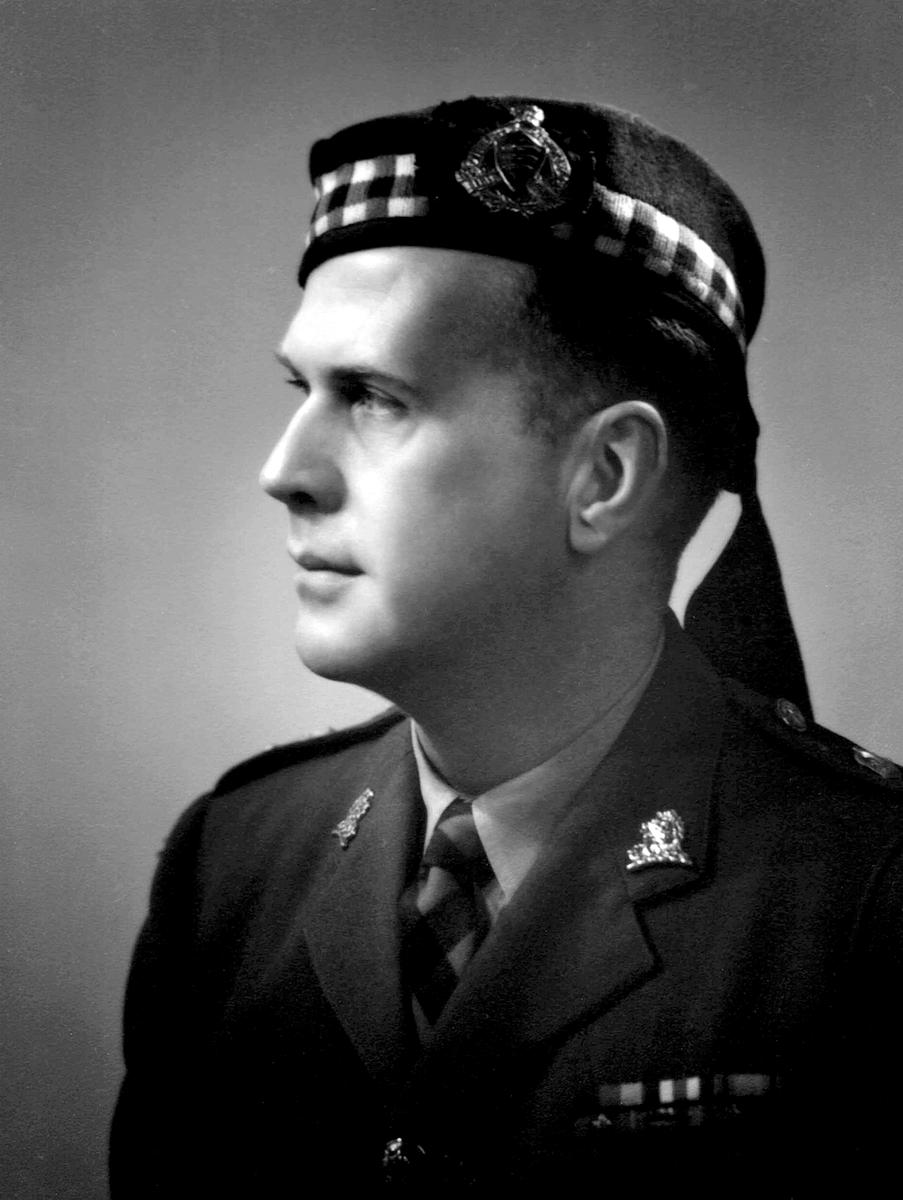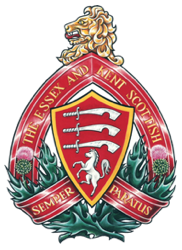A Family Vocation: The Bartlet-Wigle-McGregor and Prince Connections

Portrait of Lt.Col. W.L. McGregor, unknown date.
While professions may often pass down through families, the dedication and sacrifices needed to join the Armed Forces makes a military career more akin to a lifestyle than a job. Thus, to have multiple generations of men from the same family choose this vocation and effect significant change on their regiment is admirable. Though many members of the same family served with the Essex Scottish, the three generations of familial connections between the Bartlet, Wigle, and McGregor families is significant.
Lieutenant-Colonel Noble A. Bartlet was the Commanding Officer of the 21st Essex Fusiliers from 1902-1908. His father, Alexander Bartlet, held the position of Police Magistrate of Essex for thirty years, essentially the local Justice. The younger Bartlet led the regiment through a tour of the United States for the 1904 World’s Fair in St. Louis, Missouri. They also visited Chicago, Illinois, where the regiment were treated like visiting royalty.
In the first decade of the 20th century, there was speculation that a European war was looming due to increasing competition between European nations surrounding naval and imperial supremacy. While the European powers maintained large standing armies, the Essex Fusiliers and the Kent Regiment were reduced to practicing mock battles with toy soldiers over maps. Major Ernest S. Wigle controlled the Red Forces guarding London, Ontario. Wigle, a barrister-at-law from Gosfield Township, Essex County, was a descendent of British Empire Loyalists who fled the United States during the American Revolution. He had also been the mayor of the City of Windsor from 1905 to 1909. When Britain was called to war with Germany on 4 August 1914, Canada’s Minister of Militia and Defence, Sam Hughes, did not want Canada to miss out on the “short war” and ordered a new camp be built at Valcartier, Quebec. The 21st Regiment Essex Fusiliers and the 24th Kent Regiment sent groups of twenty and eleven men respectively, along with Captain George Musson who joined the Medical Corps. Fifteen new battalions were formed as a second contingent of 20,000 men were offered by the Canadian government to the British government for use overseas. The 18th Battalion, Canadian Expeditionary Force (C.E.F.) was formed on 1 October 1914. Wigle, now a Lieutenant-Colonel and Commanding Officer of the 21st Regiment Essex Fusiliers, led this C.E.F. battalion. The loyalist sentiment that had compelled Wigle’s ancestors was now being put to the test in the biggest war the world had ever seen. The 21st Essex Fusiliers sent 150 men overseas. The 24th Kent Regiment sent seventy-five. Wigle travelled with the men to the Wolseley Barracks in London, where he oversaw their training. While stationed there he allowed them to participate in local maple sugaring. He was considered relatively easygoing regarding discipline, but he was strict to punish those who drank too much alcohol. In England, he often played rounds of Crown and Anchor with his soldiers instead of having the men arrested for gambling on base. Later in the war while in Windsor, he helped to recruit men for the 241st Battalion, the Canadian Scottish Borderers, C.E.F.
Captain Walter Leishman McGregor (Senior) joined the 21st Battalion Essex Fusiliers in 1898. He was the son-in-law of Lieutenant-Colonel Wigle of the 18th Battalion and related by marriage to the family of Lieutenant-Colonel N.A. Bartlet. McGregor was the Commanding Officer of the 241st Battalion, Canadian Scottish Borderers, a kilted unit of the C.E.F. in the First World War. Highland dress was a strategy the regiment used to stimulate recruitment, as many of the men who voluntarily went overseas to fight had already gone by the time the battalion was formed in May 1916. McGregor was promoted to the rank of Lieutenant-Colonel to recruit and train the men in a newly formed 241st Battalion in Windsor. The regiment began accepting recruits in July 1916. This recruitment process coincided with the devastation taking place at the Somme overseas, reinforcements were desperately need at the front. This included making speeches to women in hopes of getting them to convince the men in their lives to enlist. The battalion aimed to recruit 700 men by the New Year in order to go overseas as a unit, but they only managed to enlist 509. With the addition of former deserters and last-minute sign-ups, they were able to raise the number to 552 before they left for England on 1 May 1917. Upon their arrival on 8 May, the 241st was broken up to reinforce other units. The men of the 241st suffered seventy-five casualties among their dispersed line units. Lieutenant-Colonel McGregor greeted the men when they returned home to civilian life. Other than his military pursuits, McGregor was a successful industrialist who was on national committees for the Dominion Chamber of Commerce. His brother, Gregor was the General Manager of Ford Canada from 1904 until his death in 1922. Walter McGregor, Sr passed away due to illness in 1933 and received a full military funeral.
While McGregor’s military career was not the only profession he undertook during his life, it had a profound influence on his son, Walter Leishman McGregor (Junior). McGregor Jr. became interested in joining the armed forces while participating in the Kennedy Collegiate Cadet Corps and eagerly awaited his turn to join the Essex Scottish. McGregor had served with the regiment as a lieutenant before the war began, but he was not given a place in the activated unit until December 1939. McGregor was appointed a lieutenant of an anti-tank platoon at that time. He had enrolled in law school at the University of Toronto until Colonel Pearson contacted him about the position with the battalion. After training with the Essex Scottish Regiment in England for two years, McGregor saw his first battle at Dieppe on 19 August 1942. He landed at Dieppe Beach on a Tank Landing Craft and acted as the beach control officer. The tanks he was entrusted to escort up the beach were immediately immobilized by German fire. McGregor spent the remainder of the battle trapped on the beachhead. He was taken as a prisoner of war and was taken to Oflag VII-B. While marching with other officers to Moosburg, three U.S. fighter aircraft fired upon the men, killing several and injuring one. While held in the camp, his mother arranged for him to get law casebooks and study materials in order to continue his law degree. McGregor was repatriated to Canada on 23 June 1945. He was met in Windsor by his grandfather Colonel Wigle. McGregor became the Commanding Officer of the Essex Scottish in 1948 and held the role until 1951. He is credited with rebuilding the regiment in a peacetime environment after the war. After retiring from the regiment, he practiced law with partners Stewart and McWilliams. McGregor, Jr was appointed Honorary Lieutenant-Colonel of The Essex and Kent Scottish from 1980 to 1991 and Honorary Colonel from 1991 to 1994. McGregor died in 2007 ending close to 200 years his family had direct connection with the Regiment.
McGregor’s sister, Mary, married another officer in the regiment, Lieutenant John “Don” Mingay. Mingay is credited with being the first man in the battalion to fire a shot in anger at the Germans in 1940. Mingay ended the war having served with The Essex Scottish and many senior operational staff positions at 6th Brigade and 3rd Division headquarters.
Though not related as family the McGregors and Princes had a strong regimental connection with the Essex Fusiliers. Lieutenant Colonel Alan C. Prince was Commanding Officer of the Essex Fusiliers in 1927. He is the great grandson of Colonel John Prince, Commanding Officer of the 3rd Regiment of Essex Militia 1838 to 1846. In order to boost recruiting, Lt Col Alan Prince proposed to change the regiment to a highland unit but government funds were unavailable. Prince turned to former member of the Essex Fusiliers, Walter McGregor, Sr for assistance to purchase kilts for the renamed Essex Scottish. McGregor financed the purchase of MacGregor tartan for kilts with generous assistance from Ford Canada. Thus, the McGregor name is forever linked to The Essex Scottish and The Essex and Kent Scottish and the only Scottish regiment in the world to wear the MacGregor tartan.
Story by Nicole Pillon, Canada Summer Jobs 2022 participant
with The Essex and Kent Scottish Regiment Association
Sources
- Duty Nobly Done: The Official History of The Essex and Kent Scottish Regiment by Sandy Antal and Kevin R. Shackleton: Chapters 4, 5, 8, 9, 10, 11, 13, 15
- Lt. Col. McGregor’s Interview for Duty Nobly Done
